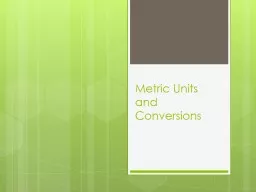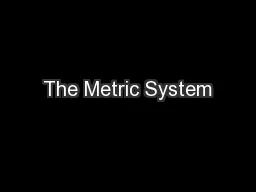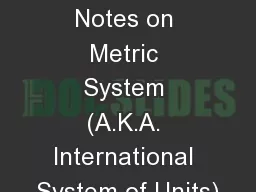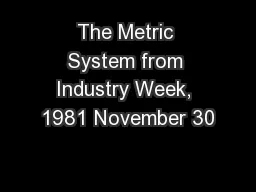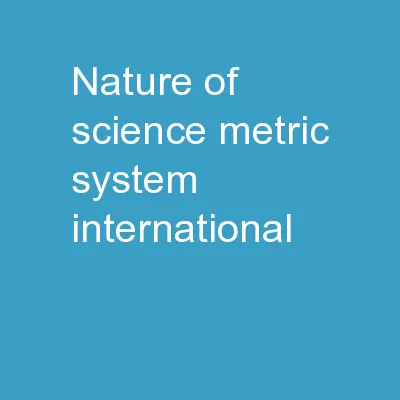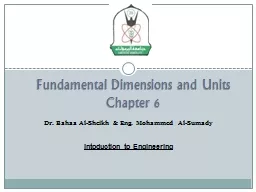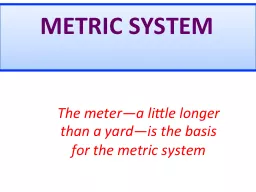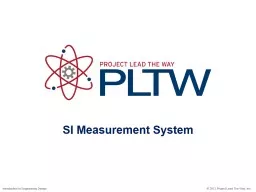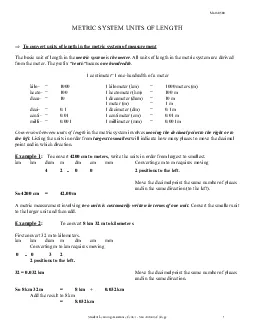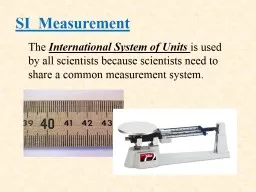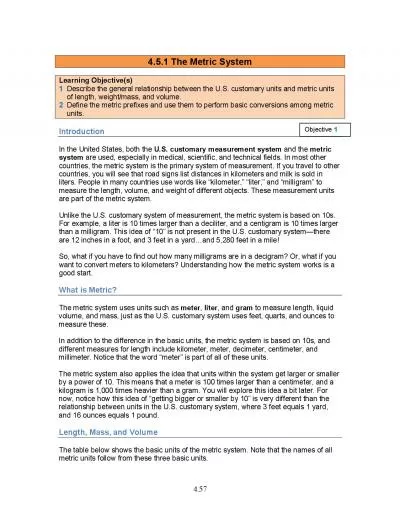PPT-International System of Units
Author : celsa-spraggs | Published Date : 2019-06-22
SI units This is the standard system of measurement used by many scientists Look at page 149 Introduction The Properties of Matter matter is anything that has mass
Presentation Embed Code
Download Presentation
Download Presentation The PPT/PDF document "International System of Units" is the property of its rightful owner. Permission is granted to download and print the materials on this website for personal, non-commercial use only, and to display it on your personal computer provided you do not modify the materials and that you retain all copyright notices contained in the materials. By downloading content from our website, you accept the terms of this agreement.
International System of Units: Transcript
SI units This is the standard system of measurement used by many scientists Look at page 149 Introduction The Properties of Matter matter is anything that has mass and takes up . Why do scientists need a standard system of measurements?. Remember that science must be . repeatable. – another scientist has to able to repeat your experiment using the same amounts, concentrations, lengths, weights, etc.. A.S. 1.1.1 – 1.1.3. Is the US a metric country? Should it be?. Read the article you’ve been handed with these two questions in mind.. 5. minutes—. silent . read and take notes.. Turn and talk to your group members (you all had the same article)—2 minutes. ~King Henry Died unexpectedly Drinking Chocolate Milk~. Unlike our . English system . of measurement with its feet and inches, quarts and gallons, . the . metric system is very . orderly . All . variations of the units of measure are really just the units multiplied by powers of 10. . Yewande Dayo. Student Pharmacist. Objectives. Demonstrate an understanding of SI units. Convert units within SI units. State equivalent measure between SI units and other systems of measure used in pharmacy practice. Measurements and Abbreviations. There are others in the Student Handout book. The most common ones (Must know). C=Celsius. F =Fahrenheit. G or gr =Gram. Gr. = grain. L= liter. Ml= Milliliter. Mg=Milligram. Why use the Metric System?. - Base of 10, making it easy to Use. - Consistent with other scientists around the world. . Metric system’s base units. -Length: meter (m). -Volume: liter (l). -Mass: kilogram (Kg). . No Cussing!. The following 4-Letter. words are forbidden here:. Inch Mile. Foot Pint. Yard Acre. And we never swear the . BIG F . (use. o. C). Please keep it clean and. Metric. SI System. The International System of Units. System of Units. (SI). Learning Targets:. Use appropriate tools and equipment for measuring. . Use the metric system for measuring. . Use the “ladder method” and dimensional analysis to convert values between metric and English units. Fundamental Dimensions and Units Chapter 6 Dr. Bahaa Al-Sheikh & Eng. Mohammed Al- Sumady Intoduction to Engineering Engineering Problems and Fundamental Dimensions when someone asks you how old you are, you reply by saying “I am 19 years old.” a yard—is . the basis for the metric system. We can . increase. or . decrease. the value of a . base. unit by using a . prefix. 10. m. k. (This is now the same as 10,000 m). SI Units are easier to remember than English units because they are based on multiples of . Introduction to Engineering Design. The International System of Units (SI). The International System of Units (SI) is a system of units of measurement consisting of seven base units. The abbreviation SI is from the French “. The basic unit of length in the metric system All units of length in the metric system are derivedone hundredth1 centimeter1 one-hundredth of a meter10001 kilometer km1000 meters mhecto-1001 hectomete is used by all scientists because scientists need to share a common measurement system. . SI . Measurement. . “The . Metric . System”. Originated 1790’s France at the request of the King to his Academy of Sciences. 4 Learning Objective(s) Describe the general relationship between the U.S. customary units and metric units of length, weight/mass, and volume Define the metric prefixes and use them to perform
Download Document
Here is the link to download the presentation.
"International System of Units"The content belongs to its owner. You may download and print it for personal use, without modification, and keep all copyright notices. By downloading, you agree to these terms.
Related Documents


